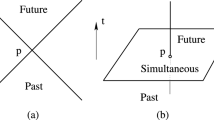Abstract
Black hole horizons are teleological in nature, that is, for locating them in a given spacetime it is necessary to know the entire evolution of the universe. Thus, it has been argued that black hole horizons cannot be observed by any astrophysical measurement. Furthermore, this nonlocal feature of the horizon seems to contradict the very basic foundation of general relativity, which is a local field theory. In this report, we will review two recently formulated local methods for detecting the black hole horizon based on the scalar polynomial curvature invariants and the Cartan curvature invariants, respectively. Then, we will enlighten both the conceptual and computational improvements with respect to the standard techniques which have been adopted so far for tackling this task. Finally, we will discuss the most relevant applications of our methods in numerical relativity both for gravitational-waves simulations in astrophysics, and in the study of the quark-gluon plasma in light of the AdS/CFT correspondence.
Similar content being viewed by others
REFERENCES
C. W. Misner, K. S. Thorne, and J. A. Wheeler, Gravitation (W.H. Freeman, San Francisco, 1973).
M. A. Abramowicz, W. Kluźniak, and J. P. Lasota, Astron. Astrophys. 396, L31 (2002); astro-ph/0207270.
R. Penrose, Phys. Rev. Lett. 14, 57 (1965).
B. P. Abbott, R. Abbott, T. D. Abbott, M. R. Abernathy, F. Acernese, K. Ackley, C. Adams, T. Adams, P. Addesso, R. X. Adhikari, et al., Phys. Rev. Lett. 116, 241103 (2016); gr-qc/1606.04855.
M. Rees, R. Ruffini, and J. A. Wheeler, Black Holes, Gravitational Waves, and Cosmology: An Introduction to Current Research (Gordon and Breach, New York, 1974).
J. M. Maldacena, Adv. Theor. Math. Phys. 2, 231 (1998).
M. Alcubierre, Introduction to 3+1 Numerical Relativity (Oxford Univ. Press, New York, 2012).
L. Rezzolla and O. Zanotti, Relativistic Hydrodynamics (Oxford Univ. Press, 2013).
D. Gregoris, Y. C. Ong, and B. Wang, Eur. Phys. J. C 79, 925 (2019); gr-qc/1902.05565.
D. Gregoris, Y. C. Ong, and B. Wang, Eur. Phys. J. C 80, 159 (2020); gr-qc/1911.01809.
M. Abdelqader and K. Lake, Phys. Rev. D 91, 084017 (2015); gr-qc/1412.8757.
D. N. Page and A. A. Shoom, Phys. Rev. Lett. 114, 141102 (2015); gr-qc/1501.03510.
D. Brooks, P. C. Chavy-Waddy, A. A. Coley, A. Forget, D. Gregoris, M. A. H. MacCallum, and D. D. McNutt, Gen. Relat. Grav. 50, 37 (2018); gr-qc/1709.03362.
A. Ashtekar and B. Krishnan, Living Rev. Relat. 7, 10 (2004); gr-qc/0407042.
A. Coley and D. McNutt, Class. Quantum Grav. 35, 025013 (2018); gr-qc/1710.08773.
E. Cartan, Leçons sur la Geometrie des Espaces de Riemann (Gauthier-Villars, Paris, 1946).
M. Bañados, C. Teitelboim, and J. Zanelli, Phys. Rev. Lett. 69, 1849 (1992); hep-th/9204099.
S. Carlip, arXiv: gr-qc/9503024 (1995).
F. C. Sousa, J. B. Fonseca, and C. Romero, Class. Quantum Grav. 25, 035007 (2008); gr-qc/0705.0758.
A. Tavlayan and B. Tekin, Phys. Rev. D 101, 084034 (2020); hep-th/2002.01135.
S. W. Hawking, J. Math. Phys. 9, 598 (1968).
S. A. Hayward, Phys. Rev. D 49, 831 (1994); g-r‑qc/9303030.
J. Kormendy and L. C. Ho, Ann. Rev. Astron. Astrophys. 51, 511 (2013); astro-ph.CO/1304.7762.
N. Kaloper, M. Kleban, and D. Martin, Phys. Rev. D 81, 104044 (2010); hep-th/1003.4777.
V. Faraoni, A. F. Zambrano Moreno, and R. Nandra, Phys. Rev. D 85, 083526 (2012); gr-qc/1202.0719.
R. Nandra, A. N. Lasenby, and M. P. Hobson, Mon. Not. R. Astron. Soc. 422, 2945 (2012); gr-qc/1104.4458.
V. F. Cardone, C. Tortora, A. Troisi, and S. Capozziello, Phys. Rev. D 73, 043508 (2006); astro-ph/0511528.
T. Johannsen and D. Psaltis, Phys. Rev. D 83, 124015 (2011); gr-qc/1105.3191.
ACKNOWLEDGMENTS
The author thanks the organizers of the fourth (virtual) Zel’dovich conference.
Funding
D.G. acknowledges support from China Postdoctoral Science Foundation (grant no. 2019M661944), and from the 2020 Galaxies travel award (Galaxies is an open access journal by MDPI).
Author information
Authors and Affiliations
Corresponding author
Additional information
Paper presented at the Fourth Zeldovich meeting, an international conference in honor of Ya.B. Zeldovich held in Minsk, Belarus, on September 7–11, 2020. Published by the recommendation of the special editors: S.Ya. Kilin, R. Ruffini, and G.V. Vereshchagin.
Rights and permissions
About this article
Cite this article
Gregoris, D. Curvature Invariants and Black Hole Horizons. Astron. Rep. 65, 947–951 (2021). https://doi.org/10.1134/S1063772921100127
Received:
Revised:
Accepted:
Published:
Issue Date:
DOI: https://doi.org/10.1134/S1063772921100127




